Grab a bowl of potato chips and dip and sit a spell.
If youse got some brewski’s, have a quaff.
Enjoy today’s installment.
MM Interview on “Super Soldier Talk”
Bob & Doug McKenzie – Twist-off Tops
They were basically mocking the American impression of Canadians, and then Americans started basing their Canadian impressions on Bob and Doug McKenzie, which was a satire of how the Americans thought Canadians talked and... I've gone cross-eyed...
Saudi Arabia takes step to join China-led security bloc SCO, as ties with Beijing strengthened. What does it mean for the US influence in the Middle East?
It should be the nail in the coffin of the US hegemony in the gulf region and the Middle East, also it will be a blowback for the US arms & ammunition sales. Even Military Industrial Complex already book the sales of their used arms and ammunition in the Ukraine war. But it is obvious that after the peace deal brokered by China of Saudis and Iran, all proxy wars in the region (especially Yemen, Libya, Syria, etc) will be finished. Because most of the wars are fought between Sunni and Shia factions. So the middle east and the gulf will be cleansed from wars in near future.
Even though the US and the west have already Ukraine war as a proxy war and arms sale, also they are trying hard to instigate another war in the heart of Asia in form of Taiwan. But in the gulf specifically, in war-torn areas like Syria and Yemen, China will be the lead in reconstruction and rehabilitation work, which will financially important in this era of global recession and slowdown.
Finally, with the strong leadership of China in regional trade blocks like SCO, RCEP, ASEAN, BRICS, and many more, the chance of disruptions or war chances is minimized (even for China and India too). So no room for USA MIC here. In Africa and Latin America, the situation is abruptly changing in favor of China instead of the USA, due to the strong influence of China. Conclusively the fall of the war-mongering policies of the USA will be no room in near future due to the peaceful rise of China and its soft power.
On 2023/3/27, China Foreign Affairs Qin Gan announced that China will sign the “Southeast Asia Nuclear-weapon-Free-Zone Treaty”. What is the treaty about?
Qin’s announcement came out after meeting with ASEAN secretary. ASEAN all welcome it, except perhaps Philippines who does not want peace in the ASEAN region.
Qin said: China will be the first one to sign the “Southeast Asia Nuclear-Weapon-Free-Zone Treaty” so as to maintain safety & stability of southeast Asian region (hereafter SA region).
China will work with southeast Asian countries to eliminate interference from country(s) outside SA region.
China will implement the rules in “Declaration on Conduct of Partners in South China Sea” that were set by countries in SA region.
China will make South China Sea a peaceful sea. A friendship sea. And a cooperation sea.
The 2023 treaty is a supplement to “Declaration on Neutralization of Southeast Asia” that was signed in Bangkok in 1971 by 10 countries in SA region.
By signing the 2023 treaty, China has promised southeast Asian countries not to install nuclear weapon in any countries in SA region.
China urges southeast Asian countries to exercise their strategic sovereignty. Do not let the US-led West lead them by their nose.
Philippines has been led by the nose by USA recently. Macros allowed USA increase US military base from 5 to 9. Before going to Japan, Macros repeated a Japanese slogan “when Taiwan has problem, so will be Philippines”.
Westerners only hear the western narrative without knowing the history of South China Sea.
Let me give a summary re South China Sea – history from natives on Hainan Island, China
Natives on Hainan Island are fishermen for generations. Can trace back to Han Dynasty ie 2000 years ago. They own a book that records the rocks/islands in South China Sea. This book 更路簿 (literal translation: distance & road record) 1更 (distance) = 10 海里 (nautical miles). It was a map & directory for fishermen in old days before there is beidou/GPS. This book is classified as world cultural heritage today.
In the past, fishermen would leave 1 person on the island (for months) so as to guard it. Or erect a sign with Chinese words to mark their territory.
Can any countries eg Philippines or Vietnam present such historical records?
Two Quorans gave detailed history of SCS. Search Quora.
1, Why does China not declare out of the UNCLOS 1982 to continuously claim 80% of South China Sea in the Chinese legal way? Answered by Johnny Fung in China World Leader
2, USA approved Chiang Kai-shek’s 11-dot line – prepared by Chiu Yu in China World Leader
American “news” for today…
The “Drudge Report”…

Prince – Purple Rain (Official Video)
On 2023/3/28, there are 2 forums going on. One whose headquarter is located in China is called Boao Forum for Asia. One is led by USA & called The Summit for democracy. What is the difference of the 2 forums?
China’s focuses on business & trading which unifies the intl community. USA divides the intl community by political system.
When USA unilaterally decides which country can join or not, USA itself is NOT democratic. … there is no justification for USA to lead the summit.
USA’s foreign policy is to DIVIDE. Divide countries & divide people inside any country. Like a gossiper dividing the friendship of you & your friend, by creating hatred or fear of the rival. By demonizing rival with lies & twisted facts.
USA divides the intl community into “democracy” & “authoritarian”.
Russia runs western democracy but is called authoritarian by USA. Aha. Now we see it. The so-called “democracy” depends on whether a country submits to USA or not. Submit to an un-democratic USA. Isn’t that an irony?
True democracy calls for respect & coexistence of the different. We dont tell others how they manage their home. Why can USA tell others how they govern their country?
See, USA is so authoritarian that they takes away other’s FREEDOM to govern their country according to their situation, culture & history.
So authoritarian that they uses arbitrary economic sanction or military to deprive people in other countries of human rights eg Economic Right to job/income, Social Right to safety, & even Right to Life in case of wars.
USA is a true AUTHORITARIAN in the intl community. But USA calls itself democratic.
China is also called authoritarian by USA because China does not submit to USA.
What is Boao Forum about? Business & trading.
Every country & individual needs economy to maintain life eg buy food, shelter, healthcare etc. Everyone can live under any political system; the world exists long before the word “democracy” was born.
Business & trading has no nationality, political system, religion or ethnicity. They speak the same language – money ie basic need for life.
BusIness & trading UNIFIES people. Not dividing people.
FYI, there is a 3rd one called China Development Forum. It is organized by Chinese government to invite world CEO eg Apple, Pfizer, BHP etc.
American “news”…
Yahoo…

CHINA/ RUSSIA NUKE WARNING to NATO
Nashville School Shooting
A guy called my radio show tonight saying he viewed video and found what HE says are discrepancies in the shoes and pants the shooter was wearing. I stopped that call dead in its tracks and I’ll tell you why.
I am not Alex Jones. He pulled that stuff with the Newtown, CT school shooting and it got him sued.
I’m NOT going to be another radio host who gets sued to oblivion by airing whack-jobs who deny reality, because those calls and their absurd theories cause emotional harm to grieving families.
Alex Jones did that, and now he’s on the hook for a Billion Dollars in damages. Oh, and all those callers to his show that pushed that bullshit, none of THEM ponied-up even one cent of that court judgement, did they? Nope! They left Alex Jones swinging in the breeze and moved on to some other outlet to push their tripe.
I’m not gonna have that shit on my show.
It is my considered opinion this shooting at a Christian School in Nashville, TN took place. I believe the victims were brutally murdered in cold blood, and the families of those victims are in my thoughts and prayers. They should be in yours too.
I will not abide absurd theories about this type of incident somehow being manufactured or in any way untrue.
If you want to push that crap, do it somewhere else. I won’t have it on my show or on my web site.
Barbecue Pork Roast, Tavern Style

Ingredients
- 2 large onions, sliced
- 1 (4 pound) pork roast
- 6 whole cloves
- 2 cups water
- 1 (16 ounce) bottle your favorite barbecue sauce
- 1 large onion, chopped
Instructions
- Place half of the sliced onions on the bottom of the slow cooker.
- Place meat on top along with cloves and the remaining sliced onions.
- Add water, cover and cook for 8-12 hours or overnight on LOW.
- Remove meat from slow cooker. Drain liquid from slow cooker and discard.
- Remove bone and fat from meat; shred meat; return to slow cooker.
- Add chopped onion and barbecue sauce.
- Cover and cook another 1-3 hours on HIGH or 4-8 hours on LOW, stirring 3 or 4 times.
- Serve from slow cooker on large toasted buns.
At around 11 am on March 23, 2013, all eyes were on the podium at the Moscow State Institute of International Relations as the world attentively awaited an important speech that was to be delivered.
It was Xi Jinping’s first important speech during his first overseas trip after he was elected as the Chinese president. The speech was highly anticipated and drew worldwide attention.
“It is a world where countries are linked with and dependent on one another at a level never seen before. Mankind, by living in the global village in the same era and on the same Earth where history and reality meet, has increasingly emerged as a community of common destiny in which everyone has in himself a little bit of others,” he said.
This major concept of human beings having “a community with a shared future for mankind” proposed by Xi soon grabbed international headlines and was quickly spread to all parts of the world through extensive media reports.
In what seems like an instant, one decade has passed since the momentous speech, and the decade has been marked by numerous and significant changes.
As the world today is undergoing profound changes unseen in a century, the historical trend of peace, development, and win-win cooperation has gathered an unstoppable momentum. The prevailing trends of global multipolarity, economic globalization, and greater democracy in international relations are irreversible. Meanwhile, the world is being confronted with complex and intertwined traditional and nontraditional security challenges with damaging hegemonic acts, domination and bullying. There is a long and tortuous way to go for the global economic recovery. Countries around the world are deeply concerned and eager to find a lasting solution to mounting crises through cooperation.
The world has gained a more profound understanding that peace, development, cooperation, and mutual benefits make the world vibrant while bullying, division, conflict, and confrontation only lead nations into strife and chaos.
The world today is also full of uncertainty. Human beings must overcome the fog of hegemonism, the prevailing Cold War mentality, the employment of zero-sum game tactics, the notion of the inherent superiority of certain civilizations, and other forms of interference, and veer away from this turbulent course of history as soon as possible. The concept of “building a community with a shared future for mankind” proposed by Xi is the ideological beacon charting this course.
UN Secretary-General Antonio Guterres once said the UN is willing to join China in promoting world peace and development, and in realizing the goal of building a community with a shared future for mankind.
A vision to future
Chinese President Xi Jinping put forward a major global concept in his speech at the Moscow State Institute of International Relations, calling for joint efforts to build a community with a shared future for mankind, on March 23, 2013. Photo: Xinhua
Truth can only be made clearer through the test of time. The great value of the concept of “building a community with a shared future for mankind” has been repeatedly validated over the last decade because of its insight into reality and a forward-looking vision for the future.
Only with insight can we see the times clearly.
Xi noted that we should expand our global vision and develop keen insights into human development and progress trends, respond to the general concerns of people from all countries, and play our part in resolving the common issues facing humankind.
Historically, the world has never been more connected than it is now, and human beings have never been more interdependent as they are today. If the Suez Canal is blocked, Europeans will run out of coffee to have with their breakfast; a severe rainstorm in Southeast Asia will increase the prices of computer hard drives in Latin America; thousands of parts for an airplane are manufactured by companies in dozens of countries; when an earthquake hits a country, news and pictures of the natural disaster can spread all over the world in a few minutes; and now the novel coronavirus disease has forced the entire world to fight together.
As we are all members of the global village and we belong to a community with a shared future for mankind, it is impossible to solve problems arising from such interconnectivity by severing links. All human beings must be seen as one in order to find the right way to deal with such problems.
A vision is the key to the future.
Xi has repeatedly used a “ship” as a metaphor to portray the future of mankind, when he virtually addressed the 2022 World Economic Forum, stating that “facts have shown, once again, that amid the raging torrents of a global crisis, countries are not riding separately in some 190 small boats, but are rather all in a giant ship on which our shared destiny hinges.”
In the last decade, the world has experienced dramatic changes and the road has been fraught with difficulties. Against this backdrop, the vision of “building a community with a shared future for mankind” is becoming more forward-looking when we consider how mankind has worked together to defeat the COVID-19 pandemic, when the UN Climate Change Conference achieves positive outcomes, and when the Belt and Road Initiative (BRI) creates many “national landmarks,” “livelihood projects” and “monument of cooperation.”
As Stephen Perry, chairman of Britain’s 48 Group Club, said in 2020, “Coronavirus [disease] is a global crisis that no country is immune from. It has proved that building a community with a shared future for mankind is the only right choice to win the battle.”
History has proved once again that nearsightedness leads nowhere and selfish interests lead only to bad results. “Building a community with a shared future for mankind” is the only way to overcome the rapids in the treacherous waters of history.
World of great harmony
Throughout the ages, people at home and abroad have shared their yearning for a better world. The idea of “a community with a shared future for mankind” continues to resonate because its approach emphasizes “commonality.”
Pursuing the concept of “Datong,” or “a world of great harmony,” is the main aim.
“We should jointly promote the building of a community with a shared future for mankind, and work together to build an open, inclusive, clean, and beautiful world that enjoys lasting peace, universal security, and common prosperity,” Xi said in relation to the vision of an ideal world. This is a clear blueprint for a community with a shared future for mankind, and a contemporary version of the ideal of “great harmony” for mankind.
Over the last decade, Xi has visited more than 70 countries on the five continents during his more than 40 overseas trips, hosted and attended a series of important multilateral diplomatic activities, proposed the BRI, the Global Development Initiative, the Global Security Initiative, and the Global Civilization Initiative, and promote a new type of international relations with win-win cooperation, all of which have enriched the vision of “a community with a shared future for mankind” and created specific ways to achieve the said vision.
This has offered China’s solution to the changing world, times, and history, and gained broad international consensus.
“It’s mankind’s common ideal to build a world in which there are no disputes, every country enjoys development, and every person lives happily,” Yasuo Fukuda, former Japanese prime minister, said at the Boao Forum for Asia (BFA) in April 2018. “To realize this ideal, political leaders in the world need to show great foresight, point out the development direction, and make their best efforts to turn the vision into a reality,” he said.
“China’s initiative to build a community with a shared future for mankind is based on such a vision and it is hoped that all countries will join hands to realize the goal,” he noted.
Facing together is an effective way to solve problems.
In China’s eyes, to truly pursue world peace, we need dialogue and consultation, and to truly benefit the global population, we should build a shared future.
As Xi said, prejudice, discrimination, hatred, and war can only cause disaster and suffering, while mutual respect, equality, peaceful development, and common prosperity represent the right path to be taken.
Over the last decade, the universal values of peace, development, fairness, justice, democracy, and freedom have gained increasing popularity. Building an open, inclusive, clean, and beautiful world that enjoys lasting peace, universal security, and common prosperity has become an increasingly common pursuit for more and more countries.
The international community clearly realizes that there is no such a thing as a superior state, nor a one-size-fits-all model of national governance, nor an international order dominated by a single country. A united world - not a divided one - that is peaceful and not volatile is what serves the common interests of mankind.
The initiative of building a global community with a shared future was initiated by China, but promoted by all.
The concept of “building a community with a shared future for mankind” proposed by Xi is extremely important, Pakistani President Arif Alvi said on March 15, 2023, adding that only by working together can countries around the world address the challenges they face, such as the COVID-19 pandemic, climate change, and poverty.
China, under the leadership of Xi, has established a better image in the world and is leading the world in a good direction, Alvi said.
Beneficial global thoughts
The charm of thought often reflects one’s great personality. The idea of “building a community with a shared future for mankind” has gained increasing popularity among the people because it reflects Xi’s spirit as the leader of a major country and a world-class leader with the aim to benefit the world while deeply caring for its people.
This spirit offers great wisdom for the benefit of the world.
“All countries should rise above differences such as nationality, culture, and ideology, to build a community with a shared future for mankind and jointly build our shared planet,” Xi has said on numerous occasions internationally while extending a sincere invitation to the rest of the world. “All countries are welcome to board the train of China’s development,” “Our aim is to turn the Chinese market into a market for the world, a market shared by all, and a market accessible to all,” “Development is real only when all countries develop together,” he said.
The facts speak for themselves. The BRI has become a quality international public goods jointly built by all parties and shared by the world.
The China-Europe freight train line, so far, runs more than 65,000 trains, making it an “iron caravan” connecting Asia and Europe. The China-Laos railway can transform Laos from a landlocked country into a land-linked hub that connects the wider region. The Chinese-built Peljesac Bridge in Croatia fulfilled the Croatian people’s dream of connecting their northern and southern territories.
This sentiment also encapsulates the Chinese’s leader’s “people first” philosophy.
Even when China was poor, it tightened its belt to help its African brothers build this [Tazara Railway] railway, Xi said when he held talks with visiting Tanzanian President Samia Suluhu Hassan in Beijing on November 3, 2022. “Now that China is more developed, it is better placed to act on the principle of sincerity, real results, amity, and good faith, to help our African friends achieve common development, and to build a stronger China-Africa community with a shared future in the new era,” he noted.
From the Tazara Railway to Addis Ababa-Djibouti Railway, and Mombasa-Nairobi Standard Gauge Railway (SGR), from the China-Cambodia Friendship Poverty Alleviation Demonstration Village Project to the provision of 1,000 training quotas for poverty alleviation at the Shanghai Cooperation Organization to various countries, sincerity and real actions all bear witness to China’s initial sincerity in seeking development with the world.
“Most of the world has said this is really how we want to move forward… China and its development, and its willingness to share that development has created a new opportunity for the world,” said William Jones, Washington bureau chief of the US publication Executive Intelligence Review.
China’s success story of poverty alleviation has given “a different direction to history,” Jones said.
By relying on independence, putting people and their lives first, peaceful development, openness, inclusiveness, and solidarity, instead of war, colonialism, and plunder, the Chinese people have blazed a new path to modernization, which is different from the Western mode.
The Chinese path to modernization has inspired many other countries, especially developing ones, to figure out a new path to modernization. The Chinese people hope and believe that as more countries in the world embark on the path to modernization, the dream of a community with a shared future for mankind will come true eventually.
Right path serves common interests
The world belongs to people from all countries, and the future of the world must be in the hands of all people. Why has the concept of “building a community with a shared future for mankind” profoundly influenced the world? Because it encourages openness, goodwill, and innovation to achieve common goals.
This right path best serves the common interests of the vast majority of people in the world.
Xi stressed that to have a community with a shared future for mankind is not to replace one system or civilization with another. Instead, it is about countries with different social systems, ideologies, histories, cultures, and levels of development coming together for shared interests, shared rights, and shared responsibilities in global affairs, and creating the greatest synergy for building a better world.
In the last decade, the concept has brought joy along the Mombasa-Nairobi SGR thanks to faster and smoother travel instead of the cries of the refugee camp; it has brought about the opening of new factories in industrial parks around the world rather than enterprise collapse in the wake of Western-proposed “decoupling”; it has transformed certain land-locked countries into land-linked hubs, prevented some countries from being sadly made into “chess pieces.”
Martin Jacques, a senior fellow of politics and international studies at Cambridge University, said that China has carried out unprecedented work at home and abroad, and offered “a new possibility” to the world.
This right path encourages active participation.
In the last 10 years, the concept of “building a community with a shared future for mankind” has been written into the resolutions or declarations of the United Nations, BRICS, and other international organizations many times over: At the bilateral level, China has resonated with many countries in the face of complicated global issues; at the regional level, the building of several communities with a shared future has enjoyed steady promotion; at the global level, communities of global development, human security, human health, and human and natural life, communities with a shared future in cyberspace, a community with a shared future in nuclear security, and a community with a shared future in the ocean have emerged.
The Global Development Initiative proposed by Xi has received positive responses and support from more than 100 countries and international organizations, including the United Nations, and about 70 countries have joined the Group of Friends of the Global Development Initiative.
Recent Saudi Arabia-Iran talks in Beijing had achieved important outcomes, which are a testament to the successful practice of the Global Security Initiative, which has been praised and supported by more than 70 countries, and was unanimously welcomed by the international community.
Xi introduced the Global Civilization Initiative at the CPC in Dialogue with World Political Parties High-Level Meeting on March 15, 2023, which was warmly endorsed by the participants and resonated widely with the international community.
The BRI has transformed from a blueprint proposed one decade ago to a reality today, turning into effective development for countries and tangible benefits for countless people. So far, it has seen the participation of more than three-quarters of the world’s, attracting trillion dollars of investment, forming more than 3,000 cooperation projects, creating 420,000 jobs for countries along the BRI route, and lifting tens of millions of people out of poverty.
It has been a decade since the concept of “building a community with a shared future for mankind” was proposed. The world has seen the power of ideas and heard the echoes of history – only when destiny is shared will the world have a brighter future.
People want to live comfortable lives, to have friends and wine in every place they go, to have a happier future for their children that’s better than they have today. No one wants to survive in uncertainty, poverty, and backwardness, to grow up in a land shrouded in hostility and intimidation.
“Building a community with a shared future for mankind is an exciting goal, and it requires efforts from generation after generation,” Xi addressed the United Nations Office in Geneva, Switzerland, on January 18, 2017.
How can we take responsibility for our children and give them a better future?
The world’s tomorrow depends on our decisions today. We believe that as long as we uphold goodwill and communicate sincerely, even the biggest conflicts can be resolved and even the thickest ice can be broken. We look forward to realizing harmonious coexistence and win-win cooperation among countries, passing on the flame of peace from generation to generation.
Chinese people are ready to cooperate with the people of the world, to always be on the right side of history and on the side of the progress of human civilization, and to walk hand in hand on the path to peace and development.
China’s rare earth countermeasures have succeeded!
The Burden Of Blogging
Some times it’s just like this. I am not feeling well. I am not sick but something is just not right.
I have no idea what to post about. Every theme and issue feels so repetitive. It is the burden of blogging, especially when one tries to post every day.
I need a pause. Likely only for a few days. I will continue to post open threads. I will continue to clean the spam queue and to somewhat police the comments. But over the next few days there will be no new original content here.
I will do something other than reading news, thinking and writing about it. I hope that it will help to clean my mind to then come back with some fresh ideas.
Artist Illustrated 25 Bad Puns To Brighten Your Day

According to an artist Irina Blok: “I am a designer based in San Francisco, and I love to doodle during my spare time. I hear many words that amuse me during the day, not sure why, but they are just too funny. Perhaps it’s a combination of being easily amused and having English as a second language. In any case, it’s a good method to escape our sad pandemic reality and deal with stress.
For example, when my mother mentioned she is doing “intermittent fasting,” an image of a person putting a mitten over their head popped into my mind. Then when I heard “thumb drive,” I saw an actual human thumb driving a car. Same with “Bluetooth” (my daughter was asking why someone came up with this name?) – in my head, I saw an actual blue tooth transmitting Wi-Fi from a mouth.
I usually write down funny words, and when I have some free time, I grab my iPad and quickly draw it. My goal is to create a new drawing every day, and I have been sharing them on my Instagram.
I really enjoyed drawing this, and I hope you’ll find these amusing too! Here are the links to my previous posts if you missed them here and here.”
More: Irina Blok, Instagram h/t: boredpanda
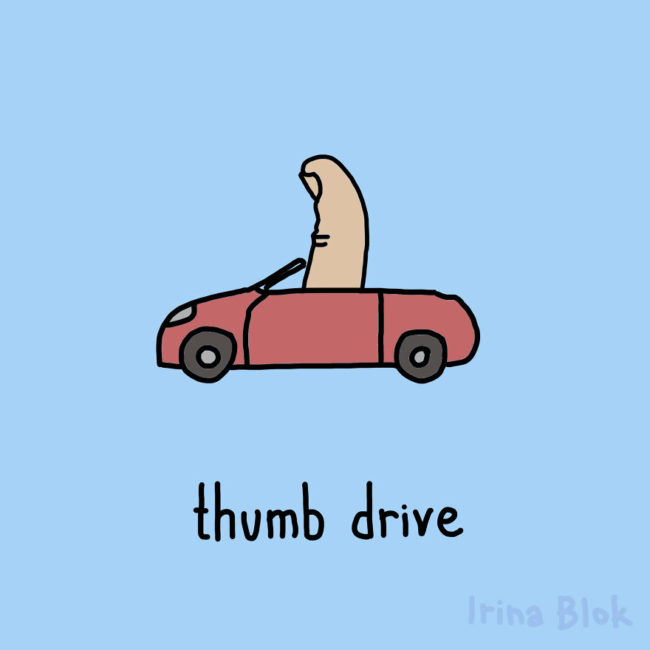







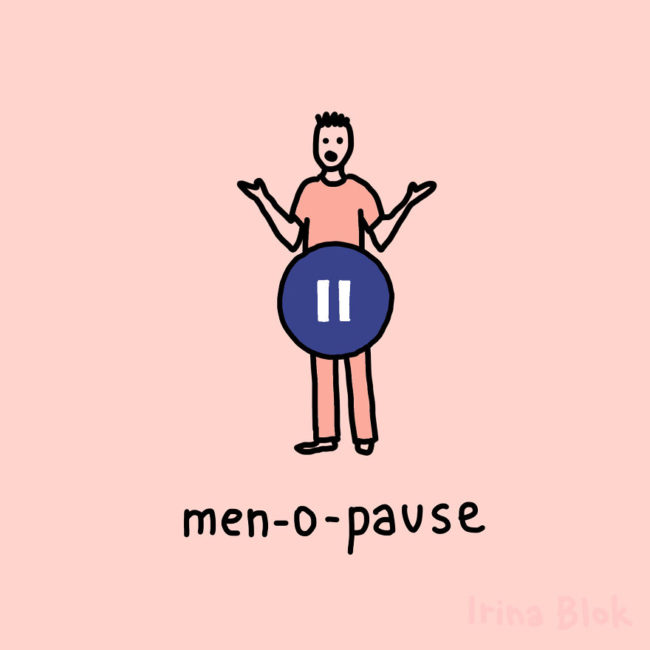






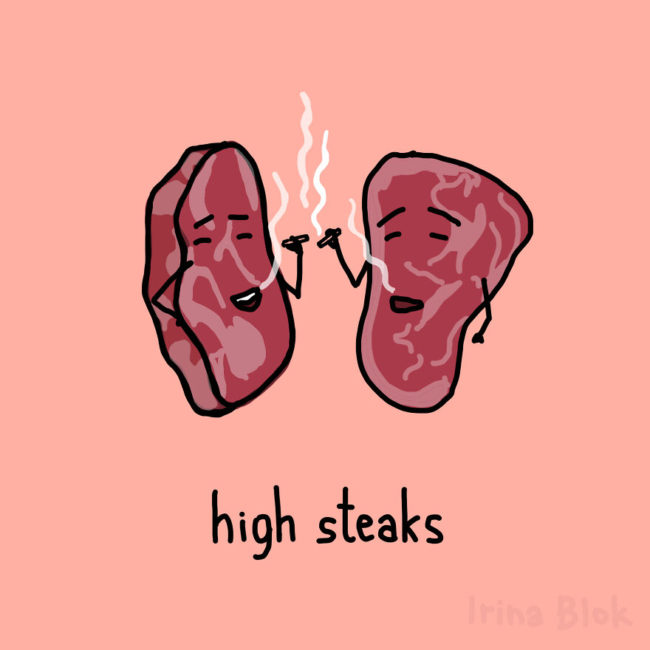
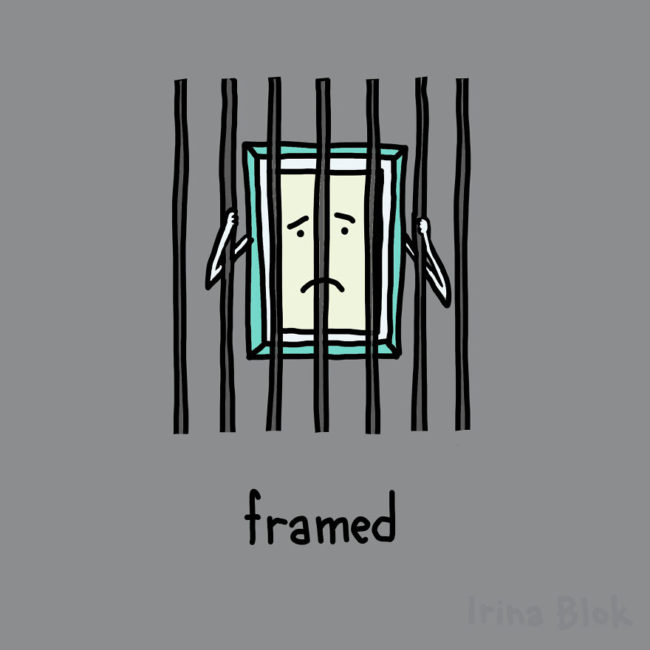
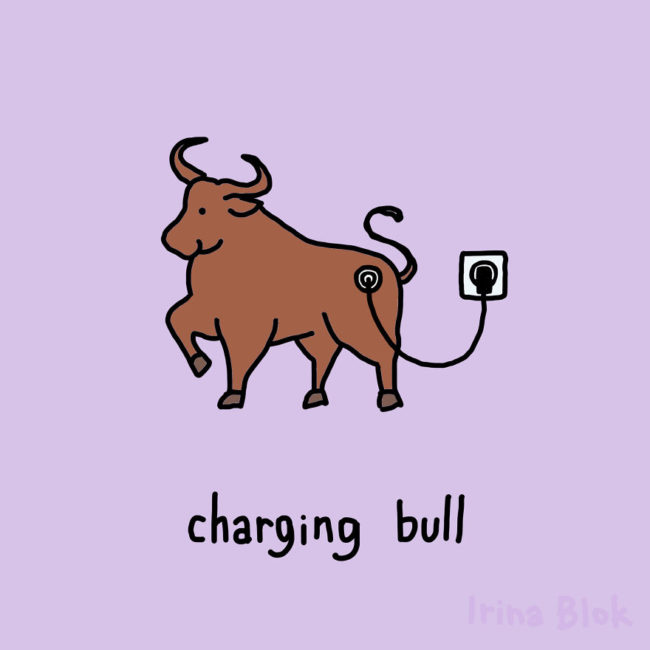


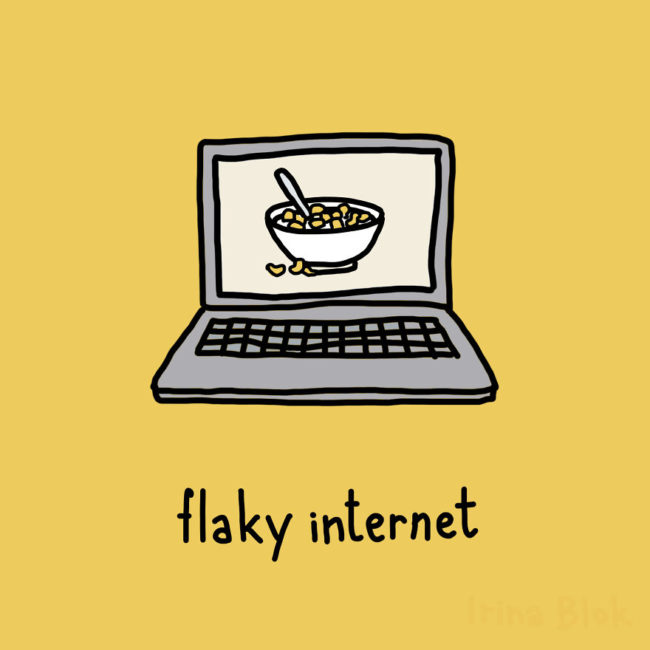
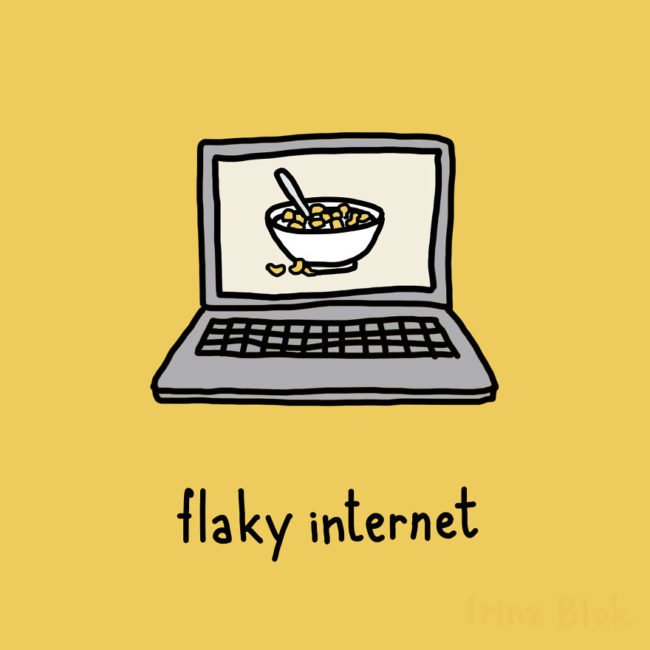


The World Has Misjudged the Semiconductor Supply Chain
https://youtu.be/NfTTUjo5FJo
What was Hitler’s last day on Earth like?
In late April 1945, chaos reigned in Berlin. Years of war had turned former superpower Germany into a battleground, and its cities from strongholds into places under siege. The Red Army had completely circled the city, which now called on elderly men, police, and even children to defend it. But though a battle raged on in the streets, the war was already lost. Adolf Hitler’s time was almost up.
The people of Germany had already taken leave of their Führer. Since a public appearance on his birthday, April 20, he had been disconcertingly absent from the public eye. In reality, he was holed up in a bunker near the Brandenburg Gate in the heart of Berlin, surrounded by his command staff and a few private citizens, including his mistress Eva Braun.
For weeks, bad news drifted into Hitler’s hideaway. As American forces advanced from the west, and the relentless Soviet tanks from the east, Hitler’s generals began to lose their heads. Suspicious of a coup by his closest advisors, Hitler raged and planned and raged again. When he learned that Felix Steiner, one of his SS commanders, had ignored his orders to stage a heroic last stand south of the city, he began to rant and cry, declaring the war lost. Later that day, he consulted with Werner Haase, his private doctor, about the best ways to commit suicide.
By April 29, the situation had taken a turn for the worse. Though Hitler married Eva Braun that morning, people were more interested in discussing suicide than celebrating a wedding.
Hitler had learned that Heinrich Himmler, leader of the SS, had given the Allies an offer of immediate surrender—an offer they promptly refused. Outraged, Hitler demanded that Himmler—once his close and powerful compatriot—be arrested.
Then Hitler heard of the death of Benito Mussolini, his counterpart in Italy. Executed and defiled by an angry mob, the dictator’s end was a powerful warning about what might be in store for the man who had promised his now-devastated country an endless empire. Mussolini’s death set the last 24 hours of life in the bunker into motion.
APRIL 30, 1945
All times are approximate
1 a.m.: Field Marshal William Keitel reports that the entire Ninth Army is encircled and that reinforcements will not be able to reach Berlin.
4 a.m.: Major Otto Günsche heads for the bathroom, only to find Dr. Haase and Hitler’s dog handler, Fritz Tornow, feeding cyanide pills to Hitler’s beloved German Shepherd, Blondi. Haase is apparently testing the efficacy of the cyanide pills that Hitler’s former ally Himmler had provided him. The capsule works and the dog dies almost immediately.
10:30 a.m.: Hitler meets with General Helmuth Weidling, who tells him that the end is near. Russians are attacking the nearby Reichstag. Weidling asks what to do when troops run out of ammunition. Hitler responds that he’ll never surrender Berlin, so Weidling asks for permission to allow his troops to break out of the city as long as their intention never to surrender remains clear.
2:00 p.m.: Hitler and the women of the bunker—Eva Braun, Traudl Junge, and other secretaries—sit down for lunch. Hitler promises them that he’ll give them vials of cyanide if they wish to use them. He apologizes for being unable to give them a better farewell present.
3:30 p.m.: Roused by the sound of a loud gunshot, Heinz Linge, who has served as Hitler’s valet for a decade, opens the door to the study. The smell of burnt almonds—a harbinger of cyanide—wafts through the door. Braun and Hitler sit side by side. They are both dead. Braun has apparently taken the cyanide, while Hitler has done the deed with his Walther pistol.
4:00 p.m.: Linge and the other residents of the bunker wrap the bodies in blankets and carry them upstairs to the garden. As shells fall, they douse the bodies in gas. Joseph Goebbels, minister of propaganda, will kill himself tomorrow. Meanwhile, he holds out a box of matches. The survivors fumble and finally light the corpses on fire. They head down to the bunker as they burn.
On May 1, Germans who can find time between shells to listen to the radio are greeted with the tones of Wagner’s Götterdämmerung—“The Twilight of the Gods.” Hitler, they are told, has “fallen at his command post in the Reich Chancery fighting to the last breath against Bolshevism and for Germany.” The Führer is dead.
Huawei has completed key technical breakthroughs in chip autonomy and 14nm EDA tools.
What Were Aztec Sacrifices Ritual Actually Like?
They were religious events first. The Aztecs believed that their gods got their sustenance from human sacrifice; and one of the basic duties of Religion is caring for your gods. The most important of these sacrifices were carried out during the 18 monthly festivals of the Solar Year.
One of these, to give you an example, was the Tlacaxipehualiztli, the Festival of the Flaying of Men, celebrated at spring equinox before the rainy season, one of the most brutal and complex.
We know about it thanks to the notes of the Spanish monk Bernardino de Sahagun, who in the 16th century interviewed old Aztec men who were still alive in pre-spanish Mexico and recounted how this festival was held in the Aztec capital:
40 days (or maybe even a year) before the festival, a captive (from war) was designated to impersonate the god Xipe Totec (Our Flayed Lord), and he was celebrated in public as living image of the God until the Festival.
He was taught courtly manners, walking about the city playing a flute, smoking tobacco and being praised by the people and the Tlatoani (the leader).
He was even wed to four young maidens representing goddesses. There were similar representants for other important gods (Tonatiuh, Huitzilopochtli, Quetzalcoatl, Chililico and so forth).
These slaves-gods were to be sacrificed on the main pyramid by cutting out the heart. There were six sacrifice-priests who cut open the slaves breast with an Obsidian knife and then cut out the heart.
After that, the corpses were rolled down the pyramids stairs. The corpses were then flayed and their flesh given to important Aztecs. Moteuczuma would have gotten the best part, the femur. The flesh was then eaten.
Other captives would be clothed in the skin of the flayed corpses and adorned with the ornaments those killed earlier wore as “gods”.
They were paraded through the city by their captors, and finally, on the next day, fought in mock combat against Eagle- or Jaguar-wariors (they only had a mock sword with feathers instead of obsidian).
Once the captive was beaten down, he was sacrificed by a priest wearing the vestments of Xipe Totec.
His heart and blood from his chest was then presented to the sun. The captor would take that blood, and walk around the city to the statues of the gods, feeding them by painting their lips with blood.
The captives corpse was then brought to his captors house, flayed, and cut up, his flesh given away and eaten.
However, there was a special link between captor and captive, and the captor wouldn’t eat of the flesh of his captive.
Poor or sick people would walk through the streets, wearing the skins of the sacrificed, begging.
For twenty days, the priests, too, would wear the flayed skins, often adorned with gold and feathers, until the next festival (Tozoztli) approached.
The skins were then stored in special containers in a cave in the Xipe-Totec temple.
There were certainly festival-like elements, but the main events were very ritualized and everyone involved hat a part to play and knew what to do.
Even the captives were probably not struggling against their fate, but from what I’ve read, walked to the place of their sacrifice willingly, and played their part in the choreography.
The religious part was the most important. The gods needed to be fed.
China’s anti-sanctions solution released! Biden’s plan may fail.
What Was it Like Living in Occupied France During WWII For the Average Person?
In France, the Nazis split France into an occupied and unoccupied zone – occupied being the north, unoccupied, or Vichy, being the south. Nazis would have been living in the occupied zone – you would have had to board one for several days at a time – from 1940, and into the unoccupied zones from 1942.
The economy certainly suffered. By the terms of the armistice, the French had to pay for the costs of their own occupation. Although the French got the Vichy government, the Nazis became less and less interested in collaborating with them as opposed to outright taking advantage of them, particularly in the economic sector. 40% of French industry and 58% percent of state revenues went towards Germany, and in 1943 Germany instituted what’s called the Service du Travail Obligatoire (STO) which was basically a labor draft. You get your papers from the Germans, you get sent to Germany or Poland to go work in a factory. You’re there for however long they want you and you don’t get to go home. It was hugely, hugely resented.
And yes, there were definitely strict rations, which became even stricter as the war went on.
The Vichy government had their own special police, called the milice. The important thing to remember about occupied France was that the Vichy gov’t legitimized itself by asserting that Vichy France was a free France. As a result, you get Vichy police in addition to the Nazi police, you get French civil servants organizing much of the “National Revolution,” etc. (Interestingly, the Vichy government also made Mother’s Day an official holiday.) The idea of French sovereignty was huge, and when the Nazis started to infringe on it by instituting things like the STO and trying to deport French nationals, then you have a problem.
As for clandestine resistance movements, that’s another post entirely, but I’ll go on.
In France you had the external resistance and the internal resistance. The former was led by Charles de Gaulle, who flew to London after the 1940 armistice and basically said that he thought Vichy was stupid and if you agreed with him, go join him. He eventually had 7,000 people in what was called the FFL (Free French Legion, I think) and they fought out of Algeria. They were rather successful. I’m not a military historian by any means, so I have no idea what they actually did, but several governments recognized de Gaulle as the legitimate leader of France and de Gaulle was able to pester Eisenhower into liberating Paris in the summer of 1944.
Then you had the internal resistance, which was much less organized. The FFL tried to hook up with them in 1942 so that all the resistance forces in France could be under de Gaule – it was a success if only because the internal resistance needed the money from the FFL. The CRN (National Resistance Council) that came out of this “merger” was generally successful? I think. They coordinated with the guerilla fighting units to distract German/Vichy forces and kept up morale after the STO/full occupation. They also helped out in the Battle of Normandy.
Planet Claire (The B-52s Cover) by Jan van Grean
What Was Life Like For a Jester In The Medieval Era?
Being a true Jester was very hard work. You had to be a one-man entertainment machine.
One had to be able to memorize long-form poetry, tailor jokes to fit the crowd, tactfully tease your patron without committing offense, and zing guests that your patron wasn’t fond of.
You had to play instruments, sing, dance, perform acrobatics, and design and maintain your own motley.
They would learn puppetry, ventriloquism, juggling, balancing, and slight of hand.
The best description I’ve personally heard to describe the life of a licensed Jester was to think of yourself as a living television.
You were to appear immediately when your patrons needed you and provide whatever form of entertainment they desired for as long as they desired.
You would sing a lullaby for the children one moment and recite accounts of bloody wars the next if that’s what was asked of you.
A sharp mind, a strong body, and a gift for improvisation were often requisite for this sort of work.
Secondly, a Jester’s job wasn’t only to make whatever noble employed him laugh. Their position as a member of court was surprisingly complex.
The most famous jesters were probably quite intelligent and quick witted, similar to our best comedians today.
A jester was given the right to say things without deference to authority, but they had to walk a thin line of not offending too many people or pushing the limits too far.
That ability to bypass deference had a lot of uses in a royal court where everyone was obsessed with being “politically correct” if you will.
A jester was able to deliver bad news to King Phillip VI of France about the destruction of his fleet by the English when nobody else dared by allegedly stating that the English “don’t even have the guts to jump into the water like our brave French”
They also provided a check to nobles who were too full of themselves. While it was expected for most in your court to agree with and support the noble, the jester was there to point out flaws.
Elizabeth I of England reprimanded one of her jesters for not being severe enough with her.
William Sommers was liked by Thomas Cromwell for often pointing out the extravagant spending of the English court.
Further, as a member of the court and an employee of the noble, they were generally well paid and granted a decent amount of influence and power.
This is REALLY bad!
Old Record Producer Hears – BABYMETAL – Gimme Chocolate – Old Guy Reaction
I'm a 44 year old metal head and I've been jamming out to Babymetal for ten years. As the rest of the music industry has drowning in trash for the last 20 years Babymetal is a breath of fresh air wrapped in metal. FYI the fans of Babymetal are known as The One and no we are not cult.......or are we?
Cajun Sausage Jambalaya
A slow cooker makes Cajun Sausage Jambalaya a snap. Be sure to check the last hour or two to keep the rice from overcooking.

Prep: 30 min | Cook: 6 hr | Yield: 8 servings (12 cups)
Ingredients
- 1 pound boneless pork loin roast, cut into 1/2 inch cubes, lean
- 12 ounces andouille sausage, cut into 1/4 inch slices
- 2 1/2 cups water
- 1 1/2 cups rice, medium-grain white
- 2 yellow onions, chopped
- 1 bell pepper (green, red, or both), chopped
- 2 stalks celery, chopped
- 2 tablespoons vegetable oil
- 1 1/2 teaspoons salt
- 1/4 to 1/2 teaspoon cayenne pepper
- 1/2 cup green onions, chopped
Instructions
- Mix all ingredients except green onions in slow 4 to 6 quart slow cooker. Cover and cook on LOW for 5 to 6 hours, or on HIGH for 2 1/2 to 3 hours. Watch carefully during the last 1 hour (LOW) or 1/2 hour (HIGH) of cooking to prevent rice from overcooking.
- Just before serving, check seasoning and add green onions.
Working as KTV Girl in Beijing
https://youtu.be/DSlFSMPe_vQ
The 10 Deadliest Battles Of The American Civil War
The American Civil War is a devastating mark on the history of America. The number of lives lost was substantial, and the social and economic repercussions, though some needed, changed the face and future of the United States forever.
These are a few of the deadliest (and most important) battles of this historic conflict.
Fort Donelson
The Battle of Fort Donelson took place in early February of 1862. Fort Donelson, located near the Cumberland and Tennessee Rivers, was a Confederate stronghold backed up by thousands of soldiers. The Union, lead by Ulysses S. Grant, attacked the fort after their initial taking of Fort Henry.
The Union won the battle, and it was a significant victory on their part, as it resulted in the surrender of 12,000 Confederate soldiers and new power in Kentucky and access into Tennessee. The number of casualties? 17,398, mostly Confederates.
Second Bull Run
The second Battle of Bull Run took place in Manassas, Virginia, and evidence of the battle can still be seen today. It was a Confederate victory resulting in 22,180 casualties, with slightly more than half of those casualties occurring on the Union side. This battle is considered one of the most important for the Confederacy.
Antietam
It’s not entirely certain who won the Battle of Antietam, but there’s no doubting the heavy losses on both sides, resulting in 23,100 casualties. The result of the battle was the Confederate retreat across the Potomac, after the battle took place in Maryland, in mid-September, 1862. Not long after the battle occurred, President Abraham Lincoln gave his Emancipation Proclamation, one of the most important events in American history. While this battle certainly isn’t the deadliest on our list, it is significant, as September 17th was the bloodiest day in America’s military history so far.
Stones River
This Tennessee Union victory was not far ahead of the Battle of Antietam in terms of casualties, coming out at 23,515. After a Kentucky battle, Confederate and Union troops clashed outside of Nashville in December of 1862. The battle began on New Year’s Eve, took a small recess on New Year’s Day, and then resumed on January 1st, 1863. It lasted until January 5th when the last of the Confederate troops retreated further into Tennessee. When the troops retreated, the Union did not follow, proclaiming a victory for themselves and awaiting their next opportunity.
Shiloh
Another Tennessee battle, the Battle of Shiloh took place in April of 1862. The Union did win this battle, although they suffered the most casualties. The total number of fatalities was 23,746, and 13,047 of these fatalities were on the Union side. However, despite this, they still won the battle.
The Confederacy lost a chance to overpower the Union troops, after the Confederacy launched an attack on General Ulysses Grant at Pittsburg Landing and the Union called for reinforcements and the Confederates lost their general. After a counterattack planned by Ulysses, the Confederates were forced to retreat, despite their better numbers.
Chancellorsville
The Virginia Battle of Chancellorsville took place nearly a year later, in 1863, taking place in late April and early May. The Confederates took the victory under General Robert E. Lee, and there was a total of 24,000 casualties, approximately, with the Union suffering 14,000 and the Confederacy suffering 10,000. The battle is told in many history books as General Robert E. Lee’s best and most important victory throughout the war. However, the Confederacy also suffered a huge blow during the battle with the death of Stonewall Jackson. The worst part? Jackson was killed by his own men, accidentally wounded at night due to a soldier mistaking his identity.
The Wilderness
In May of 1864, more than 100,000 Union troops went head to head with only 60,000 Confederates. With Ulysses Grant newly in charge of the entire Union army, he planned to attack Robert E. Lee in what was to become a historically tragic battle. The Union lost about 17,666 men and the Confederacy lost about 11,000 for a total of more than 28,000 casualties. Worse yet, one night, with many of the dead and dying lying about the battlefield and camps, a fire broke out over the landscape, killing those who could not escape. The resulting scene of the Battle of the Wilderness has been depicted as one of the most horrific of the war.
Spotsylvania Court House
Taking the third spot on our list, the Battle of Spotsylvania Court House took place near the same time as the Battle of the Wilderness, also in May 1864. Again, there is no clear winner in this battle, but there were almost 30,000 casualties, though more were on the Union side. The battle saw Generals Grant and Lee go at it again, for nearly two weeks, in a series of battles often grouped into one in retelling. Many important military figures on both sides were killed, before the two sides broke it off and the Union continued their march to Richmond, Virginia.
Chickamauga
The Battle of Chickamauga took place in Georgia, in 1863, resulting in 34,624 casualties, split almost evenly between both sides. The Confederate army won, forcing the Union army back into Tennessee. While the battle did not play much of an important role in the overall war and was not significant on either side, it was the second most deadly incident over the Civil War, earning it the second spot on our list of the Civil War’s deadliest, bloodiest battles.
Gettysburg
Arguably one of the most well known and the most easily recognizable battles in the Civil War, the Battle of Gettysburg was also one of the absolute deadliest. The three-day event resulted in more than 50,000 casualties. Regardless of its date almost two years before the war’s end, it was the beginning of the South’s destruction. From this point forward, the South no longer attempted to invade the North with their war efforts, and battles were fought on Southern ground. The battle site, in Pennsylvania, is one of the most popular, if not the singularly most popular, Civil War site in the country.
David Bowie – China Girl (Official Video)
The Complete Guide to What Every Man Should Keep in His Car
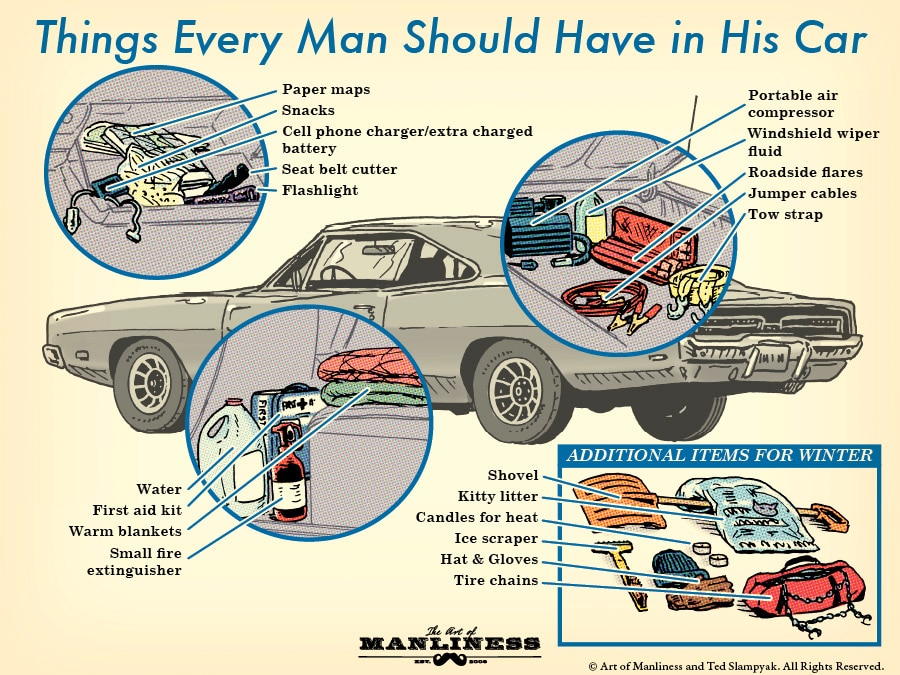
When I was growing up, I noticed that my father kept his car well-stocked with supplies. A lot of the equipment was for his job busting poachers as a game warden, but most of the things were for emergency situations that could happen to anyone. And there were plenty of times when my dad was able to put those supplies to work.
Be it a maintenance issue or a snowstorm, keeping the following items in your vehicle can save you time and discomfort, and perhaps even your very life, should an emergency arise. Obviously, the necessity of some items depends on the environment in which you live/are driving through (you don’t need an ice scraper in Tampa) and the season (though it’s best just to stock this stuff and keep it stocked, rather than removing/adding things as the seasons change).
1. Paper maps. Sometimes — okay, plenty of times — Google Maps or Waze doesn’t want to cooperate. And if you don’t have service, their reliability is of no import anyway. It’s always a good idea to keep paper maps handy of the areas you’ll be driving through.
2. Snacks/MREs. You never know when you’ll be stranded for long periods of times in your car. And depending on where you are, you could be dozens of miles from the closest source of help. Keep some MREs or granola/power bars in the back of your car to munch on while you wait for a tow truck to come, or to sustain you for a long walk to a gas station to call for help.
3. Cell phone charger/extra battery. Cell phones, and their batteries, are notoriously unreliable and quick-draining in emergency scenarios. It’s like they know when you need them most. Build some redundancy into your car’s emergency kit by keeping both a charger, and an extra battery. No excuses; they’re cheap these days.
4. LifeHammer. Should an accident trap you in your car, this rescue tool could save your life in a couple ways. It has a seat belt cutter, a steel hammer head that easily breaks side windows, and a glow-in-the-dark pin for easy retrieval in the dark. Every car should have one easily accessible!
5. Flashlight. Good for providing light at nighttime when 1) putting on a spare tire, 2) jump starting another car, or 3) exchanging insurance information with the clueless driver who rear-ended you at a stop light. Get a Maglite and you can also thump would-be carjackers in the head with it.
6. Portable air compressor. When your tire is leaking but hasn’t totally blown out, instead of putting on a spare, you can use a portable air compressor to get back on the road. The compressor fills your tire up enough to allow you to drive to a repair shop to get it fixed. It plugs right into your cigarette lighter. Bonus use: no more paying 75 cents to fill up your tires at stingy gas stations.
7. Windshield wiper fluid. Few things are as indispensable as wiper fluid. Dirty windshield, no fluid, and wet, dirty roads? Get used to stopping every 10 minutes to clean the windshield. Always have some in the car for when you inevitably run out and need it most.
8. Roadside flares. When pulled over on the side of the road, you’re basically a sitting duck, hoping that other drivers don’t clip you. It’s especially dangerous at night. Ensure that you and those around you are visible when you pull over by using road flares, or at least a reflective triangle. The old school flaming flares seem to be harder to find these days as people switch to the LED variety.
9. Jumper cables. You walk out to your car after a long day of work, stick the key into the ignition, give it a turn, and…click, click, click. Crap! You then look up and notice you left the dome light on all day. It happens to the best of us. Car batteries die, so be ready with a set of jumper cables. And even if you never suffer a dead battery, it’s always good to have a set of jumper cables so you can help a damsel (or dude) in distress who needs their car jumped.
10. Tow strap. Get your car unstuck from anything with a tow strap. Attach one end of the strap to the front of the car that you want to pull and the other to the hitch on the back of your car. The stranded driver stays in the dead car, puts it in neutral, and gets freed. Easy as that!
11. Water. For when you’re stranded in Death Valley in the middle of the hottest heat wave on record…or for any other time your car decides to break down on you. Also for when you’ve been on the trail and are parched because you didn’t pack enough in your hiking pack. Always keep a few bottles handy in the trunk.
12. First aid kit. Whether you’re cleaning up a head wound filled with glass shards or fixing a boo boo on your two-year-old, it’s good to have a first aid kit. You can always buy one, but putting together your own in an Altoids tin is more fun.
13. Blankets. Blankets have uses that go beyond emergency situations. It’s always good to have a blanket in the car for snuggling with your gal while you cheer for your team on a cold fall night or for laying it on the ground for a picnic. Get the space-saving (but not very romantic) emergency Mylar variety, or something a little classier like the Paria from Rumpl.
14. Fire extinguisher. Car fires can be especially dangerous because of the flammable liquids coursing through their systems. Keep an extinguisher in the car that can be used not only for your own emergencies, but for others who might be in danger as well. An auto extinguisher is useful, as it will be rated for putting out car-specific fires that are fueled by gasoline and oil.
15. Shovel. There are a couple of instances where a folding shovel might come in handy. The first is when you get stuck in the snow or ice. You can use the shovel to dig some snow out and place some dirt under the tire to get more traction. The second situation is when a car tire gets stuck in a hole or something. You can use the shovel to dig about and create some ramps to help get your car unstuck. Also, it can be used as an improvised weapon.
Winter/Snow-Specific Items
16. Kitty litter. Kitty litter? For traveling with your cats and they need a potty break? Hardly. Kitty litter is extremely useful as a traction device when you’re stuck in the snow or ice after a skid gone wrong. It’s not usually that you’re buried in snow that keeps your car from moving, but the slickness of the surface you’re trying to move on. Throw a handful of kitty litter in front of the tires, and they’ll have some traction to help get you on the road again.
17. Multi-wick candles. If you’re stranded in a broken-down car in the winter, you might need more than just a blanket. An actual heat source will come in mighty handy. Have a multi-wick candle (the single wick kind don’t provide adequate warmth) on hand (and matches!); it can keep your car warm for quite awhile. Candles are expensive, so make your own on the cheap (and you save even more money going scentless).
18. Ice scraper. Don’t be the chump who’s out there scraping their windshield with a credit card at 5AM in the morning. A good ice scraper will set you back just a few bucks from most any convenience store, and it will make clearing your windshield much easier and much faster.
19. Hat and gloves. Along with a blanket, make sure your head and hands stay toasty warm too. The thicker the better here; you aren’t going for fashion, but survival.
20. Tire chains. Not only are tire chains handy in wintery mountain passes, they’re actually required in some states. Don’t get stuck in the mountains; don’t get a ticket for not having chains.
BABYMETAL – PA PA YA (feat F HERO) – Old Guy Reaction
How to Escape a Sinking Car: An Illustrated Guide
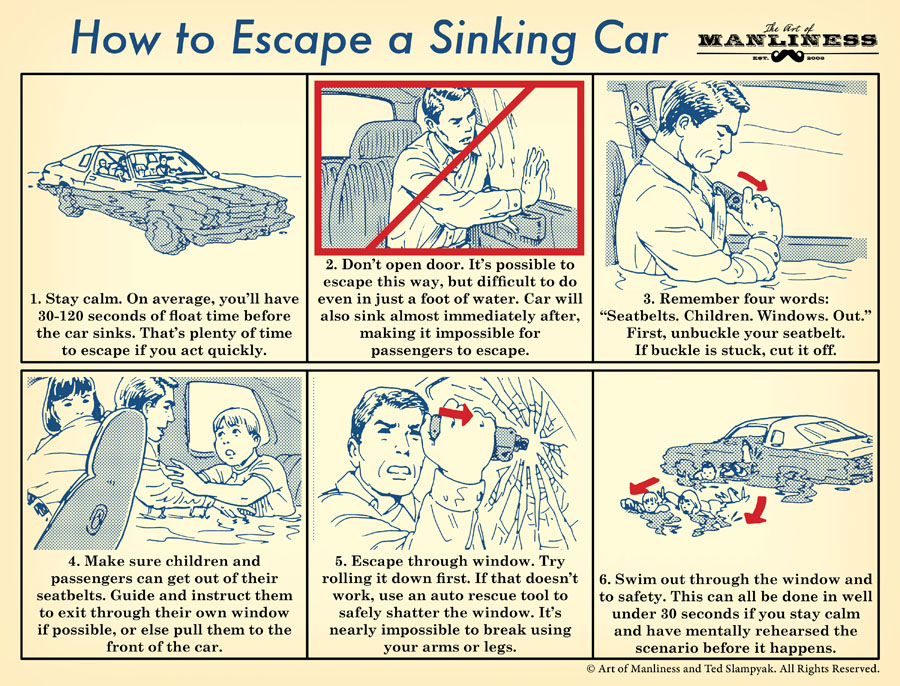
Nearly 12% of the bridges in the United States have been deemed “structurally deficient” by the Federal Highway Administration. It’s scary to think that one might collapse while you’re driving over it, plunging your car into the water below. Becoming a victim of bridge collapse is hardly the only way to end up in a submerged vehicle, however. Many drivers simply skid out around a curve, go over a guardrail, and end up in a body of water. According to some studies, over 10,000 water immersion auto accidents happen each year.
Finding yourself in a sinking vehicle can be a terrifying experience and panic can keep you from being able to escape. Memorize these easy-to-follow tips so you can stay calm and get out quickly and safely if this ever happens to you. You don’t have to know every detail, but remember these four words: “Seatbelts. Children. Windows. Out.”
Stay as calm as possible. When you have gallons of water filling your car, it’s hard not to panic. But when the difference between life and death comes down to a matter of minutes, having a clear head is essential to your survival. Panic is often the reason people drown; they lose the ability to think straight and don’t know what to do. The women in the North Dakota accident called their friends on their cellphones! But panic=death. Hyperventilating and wasting your energy on ineffective actions closes off the easiest options of escape, wastes precious oxygen and shortens the amount of time you’ll be able to hold your breath when making an escape. Just concentrate on what you need to do.
Your best chance of escape is the first 30-120 seconds. In research done on the subject, it was found that in the vast majority of situations a vehicle will actually float for 30-120 seconds before sinking. This is your best chance at escape. Stay calm, but also act quickly. If you have your wits about you, 30 seconds is plenty of time to escape, even with passengers.
Do not wait for the pressure to equalize! When your car starts really sinking, the differential between the pressure outside the car and inside the car makes opening the door impossible. So people are commonly told to wait until the car fills completely with water in order for the pressure inside and outside of it to equalize, at which point you will supposedly be able to open the door. But two shows, Mythbusters and Top Gear have tested this theory and found it wanting. The inside/outside pressure will eventually equalize, but it won’t happen just as soon as the car fills up with water. It takes a bit longer, so long that you’ll likely drown before it happens. It is possible if you are patient, calm, and conserve your oxygen, but don’t count on it.
The door is an option, but not your best option. There are still some experts that say your best chance of escape is through the door right as you hit the water. In our research, however, this theory is losing steam. Sure, you have the ability to escape through a door if it’s done immediately, but there are a few serious downfalls. One, if you try and can’t do it, you’ll have exhausted much of your energy. Then you’ll be panicked, which is bad. Two, it requires a tremendous amount of strength to open a door, even in just a foot of water. You may be able to escape that way, but can your wife and kids? Third, if you escape through the door, the car will pretty much immediately sink, rendering it impossible for passengers to escape. If you’re a strong man, you can go this route, but only as a backup plan and if you’re the only passenger in the vehicle.
Roll down or break a window. Simply put, the window is your best chance for escape. If the waterline has not risen past the windows, try rolling down the window first. Contrary to popular belief, Mythbusters found that automatic windows don’t immediately short circuit underwater. But as the car sinks, the pressure of the water will prevent you from rolling them down. This is even the case with manual windows. Even if you’ve got Popeye-sized biceps, you won’t be be able to overcome the pressure and roll down the windows. You’ll probably just break the crank.
So if rolling down the window doesn’t work, you’ll need to break the side window to escape. This is actually harder than you might think as the windows are made of strong, tempered glass. While the windshield is easier to shatter, they’re designed to be unbreakable and are laminated with a plastic sheet that could keep you trapped in the car. If you’ve been doing your push-ups and pull-ups, you might be able to break the side window with your elbow or fist. Aim for the corner of the window. But this is extremely difficult. The water significantly slows down the force of your movements. The Mythbusters were unable to break it with a kick from a steel-toed boot. Even if you are able to punch it through, your risk cutting up your hands on the broken glass. Remember the scene at the beginning of Karate Kid II when Cobra Kai sensei John Kreese punched through some car windows? Yeah, your hands could look like that. Wrapping your hand in something can help reduce the chance of slicing them up.
Your best option is to have some sort of device in your car at all times that allows you to easily break your windows in case of an emergency. The LifeHammer or the T3 Tactical Triage and Auto Rescue Tool are two tools you might want to consider keeping in your car. The former has a hardened steel tip while the latter has a spring loaded steel tip window punch, which allows you to break strongly tempered windows with the push of a button. They also have cutting devices that will cut through a seat belt if you find that you can’t unbuckle yourself. Keep them in a place that will be immediately accessible in case of an accident; you don’t want to be rummaging through your glove compartment as your car fills with water.
Escape through the window. If the waterline is still below the car window, escaping from the window will be pretty quick easy. If the waterline is past the window, keep in mind that as soon as you break the window, you’ll be hit with a flood of water. But you should still be able to swim out. Watch Adam from Mythbusters “break” the window and make his escape:
Swim to safety. Push off the car and swim to the surface. If you’re disoriented and don’t know which way is up, look for bubbles and follow the direction they’re going.
What to Do with Passengers
First, don’t open the door to make your escape. While you might be able to get out, the car will quickly fill with water and sink rapidly, possibly trapping your passengers in a watery grave. Instead, roll down or break the window.
Escaping from a sinking car is hard enough by yourself. But what if you have passengers? The first goal is to keep them calm. Take control of the situation by explaining exactly what you’re about to do. When people see there’s a plan, they’ll usually calm down. Make sure they can get out of their seatbelts. If the buckles don’t work, they’ll need a cutting tool. A child can escape from the rear window, but know that they are smaller than front windows. If it’s a small child, pull them up to the front and get them out of your window and follow after.
Prince & The Revolution – When Doves Cry (Official Music Video)
More American “news”…
No wonder Americans are considered to be ignorant and boorish by the rest of the world.
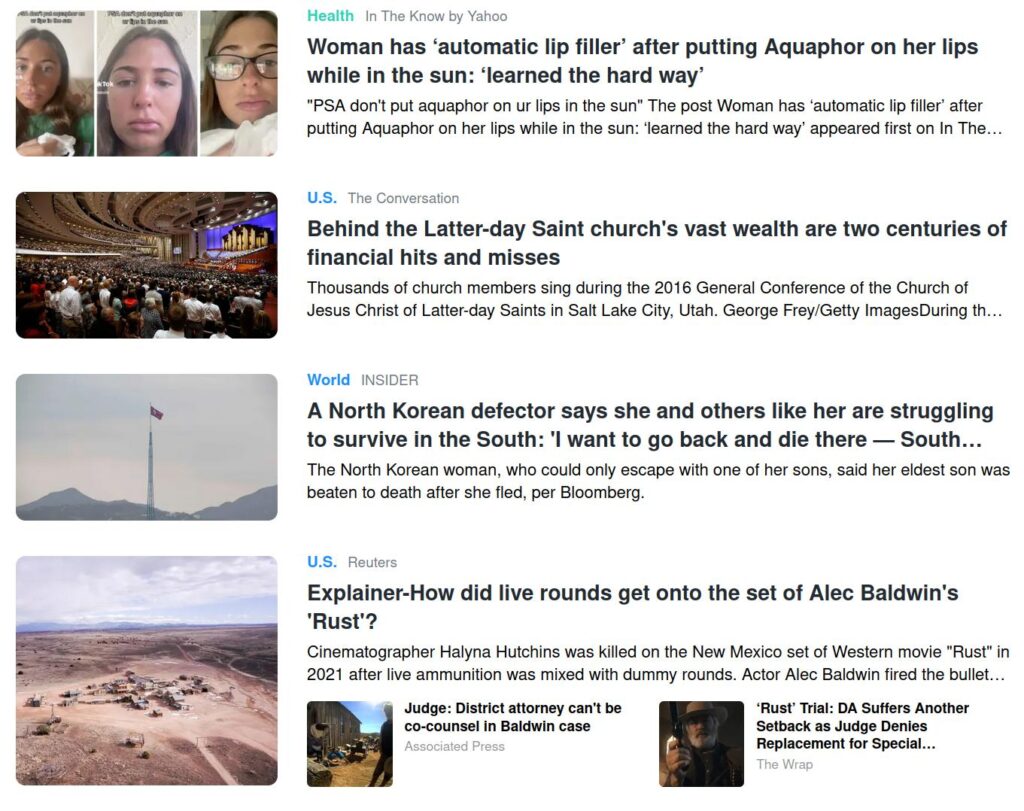
Is it true that every single piece of information on TikTok is automatically transferred to the Chinese communist party intelligence?
Of course. Every time you post a funny cat video on TikTok, the Chinese intelligence agents want a full report on the colour of the cat; its age and gender; and its exact location by GPS.
Don’t you know? Every aspect of your personal life that you post on TikTok is a grave matter of national security. Such as what you ate for lunch, snd the new pair of shoes you bought, and the latest video game you’re playing.
Besides, the CCP intelligence officers have nothing better to do but watch millions of TikTok videos all day long.
Strange Brew 1983 : Van Jump scene..
USA media believe that the USA’s tech war against China and a possible military war will completely cripple China and the USA will reign supreme until the end of the century. What’s your opinion?
It’s clearly not working. Trump’s trade war cost the US 1,800 factories and 250,00 jobs. Trump and US experts said that the US would win the trade war in 2 weeks. 2 years later. the US is the one that has suffered massive damage.
And now Biden would have you believe that the US is going to stop China from producing chips. Well, SMIC just started mass production of 12nm chips with Chinese equipment. SMIC was already producing 7nm chips and no one knew until some reverse engineer took apart a SMIC chip to see what process node was used and discovered, to his surprise, that it was 7nm.
None of the equipment China is currently using stopped working. They are still producing chips.
SMEE just released their 28nm machine to a customer for testing in production. Which means that it will be mass produced this year. With 28nm machines, China can make 7nm chips using all Chinese equipment.
Huawei just came out with 12nm EDA software for designing chips at 12nm. So expect 7nm or smaller for EDA software this year or early next year.
As far as the military is concerned. China is a peer. Which means that China has comparable technology or better. Everything the US uses must be brought by ship. China has zero logistics for their fight with the US should the US start a war.
China’s industrial capacity is more than the US and the EU combined. And China has already stockpiled enough missiles to sink double the number of US ships in existence. So even if the US convinced all NATO nations, Japan, South Korea, Australia to send everything they have. They will all be sunk.
The problem for the US is that each ship has limited ammo. The ships have maximum of 90–120 VLS launch cells. They carry anti-missile missiles and land attack missiles. The mix is about 1/3 to 1/2 anti-missile missiles.
It is SOP to fire 2 missiles per incoming anti-ship missiles.
China has 1,200 frontline fighters like the J-15, J-16, J-20. Each can carry 6 air to air missiles or 4 anti-ship cruise missiles. China has around 500 H6 bombers that can carry 5 anti-ship cruise missiles each. China also has a large drone fleet of around 500. Each drone can carry 4 air to air missiles or 2 anti-ship missiles.
Go look up the number of US destroyers. And do some simple math. You will find that the US doesn’t have enough ships or fighters. Which means that everything the US, NATO, SK, Japan, and Australia will be destroyed or sunk.
Notice I didn’t even bring up Chinese ships or submarines or land launched anti-ship missiles or hypersonic missiles.
So the US government has seriously mis-calculated. The US simply can not win. The current policy will backfire. we can hope that the US won’t be stupid and start a war that the US will lose.
In 3 days EVERYTHING changes for the US Dollar | Redacted
The Countries Bailed Out by China:
A new report published by the AidData research lab at Virginia’s College of William & Mary sheds some light on the usually nontransparent practice of Chinese bilateral emergency loans. The researchers that also hail from the World Bank, Harvard University and the Kiel Institute for the World Economy identified 22 countries that were bailed out by Chinese loans when they ran into liquidity problems between 2000 and 2021.
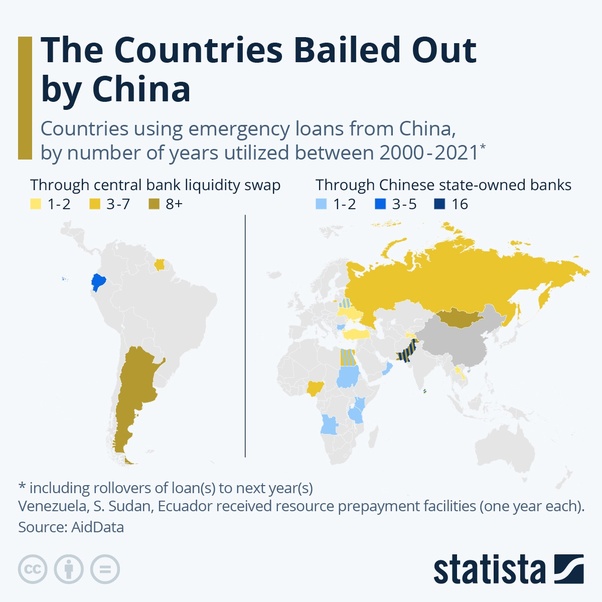
Countries that utilized these loans in an especially high number of years, i.e. rolled over their loans into subsequent years include Pakistan, Mongolia, Argentina and Sri Lanka. The latter country tapped China’s central bank for the first time in 2021 before defaulting on its debt anyways in 2022. Argentina and Mongolia were also identified by the report as countries that have been in dire financial distress since the early 2010s and were using China as a lender of last resort despite the country’s loan terms being less favorable than lower-interest bailouts offered by the IMF or the U.S. Fed. The list of Chinese bailouts also includes countries experiencing major inflation events, like aforementioned Pakistan, Turkey and Egypt.
Bailout amounts provided by China remained quite low in the 2000s and early 2010s, before shooting up from 2015 onwards, climbing to a total of $100 billion for the two decades. The two most common ways in which these loans work is through a liquidity swap with the Chinese Central Bank – where most of the outstanding balances of around $40 billion were located as of 2021 – or through credit lines from Chinese state-owned banks. Three countries, Venezuela, South Sudan and Ecuador, received prepayments on goods they were to deliver to China.
CIA Larry Johnson: “What’s Coming IS WORSE THAN A WW3, THIS IS SERIOUS” in Exclusive Interview
https://youtu.be/nhWXUowhInA
The West is stuck between the public sentiment which it contrived and the reality on the ground, Alastair Crooke writes.
Consequential Strategic Change – Upon leaving his meeting with Vladimir Putin, Xi Jinping said to Putin, “Change is coming that hasn’t happened in 100 years – and we are driving this change together”.
The ‘Entente’ was sealed during hours of talks over two days, and amidst a plethora of signed documents. Two powerful states have formed a duality that, in marrying a gigantic manufacturing base to the pre-eminent raw materials supplier and the advanced weaponry and diplomatic nous of Russia, leaves the U.S. in the shade. A seat in the shadows (assumed through volitation, or inability to contemplate such radical transition) reflects the U.S. with its back turned towards participation in the unfolding multipolar world.
With the U.S. in thrall to hegemony, the emergence of a global trifurcation is inevitable – including the three spheres of trade war: Eurasia, led by Russia China; Global South influenced by India – and with the U.S. dominating over the EU and Anglo-Sphere.
But that was not the essence of what President Xi meant by ‘change’; trade, military interchange and monetary system change were already ‘baked in’. What Xi and Putin are suggesting is that we must cast aside the old spectacles of western orientalism, by which we have been accustomed to view the world, and to think it differently and in diverse ways.
Transformation is never easy. How is the U.S. political class reacting? =It is flailing about wildly. It is deeply spooked by the manifestation of this new entente. It has lashed out, as usual, with a propaganda outpouring: Putin got little from Xi’s visit, bar pomp and ceremony; Xi’s was a ‘bed-side call’ on an ailing patient; Russia humiliated by becoming a Chinese resource colony –and to top it all, the summit failed to find a Ukraine resolution.
All of this propaganda is nonsense, of course. These are canards thrown to the winds. Washington understands how compelling is the Chinese narrative: China seeks harmony, peace and a meaningful way of life for all. America, however, stands for domination, divide and contain – and bloody, colonial-type forever wars (in the China meme).
Xi’s narrative has traction – not just in the ‘refuse-to-be-aligned’ world, but significantly within ‘Other America’, too. It even resonates a tad in otherwise wholly ‘tin-eared’ Europe.
The problem here, is that these ‘two Americas’ – the entitled Oligarchy and ‘Other America’ – simply were not able to discourse with each other, and have withdrawn into separate spheres: The western tech-platforms (such as Twitter) were knowingly configured so as to precisely not listen to ‘Other America’. And to cancel, or de-platform, contrarian voices. Today’s anti-Russian schema is yet another derivative of ‘nudge psychology’, originally trialled during Lockdown: Then ‘Science’ (as determined by the governments) offered public ‘certainty’, and at the same time stoked fear that any non-compliance with government rules might lead to death.
The moral certainty (claimed from following the ‘Science’) gave justification to judge harshly, condemn and dismiss people who in any way questioned Lockdown. Today’s geo-political psychological ploy – a derivative from the Lockdown precedent – is to ‘paste’ to the geo-political sphere the woke position of zero tolerance towards questioning supposed principles ‘that are inviolable’ (such as Human Rights). Thus, the schema uses the narrative ‘clarity’ of Russia’s ‘illegal, unprovoked and criminal invasion of Ukraine’ to give the western public the satisfying sense of righteousness needed to similarly judge harshly, oust from employment, and publicly denigrate any who expressed support for Russia.
This is viewed as an Intelligence Success, by contributing to the objective of maintaining NATO ‘burden sharing’ – and in ensuring across-the-board western expression of ‘moral outrage’ at all things Russian.
The West’s ‘Certainty Ploy’ may have worked, in that it deceptively has kindled a moral fury within a large segment of public opinion. Yet it can also be a trap – by firing up such emotionally charged propaganda; the force of the latter now limits western options (at a time when the circumstances of the Ukraine war are much changed from what had been expected). The West is now trapped by that public opinion that views any compromise that is not one of full Russian capitulation to violate its ‘inviable principles’.
The notion of exposing differing facets to a conflict (which lies at the crux to mediation), providing differing perspectives coming into view, becomes intolerable when set against ‘black and white’ righteousness. Xi and Putin are held by the western media to be so morally deficient that many fear being scorned for being on the wrong side of the ‘moral’ fault line on such a contentious issue.
Notably, this ploy does not work in the rest of world, where wokism has little traction.
There is however a substrata of Ruling Class worry about this denial technique. Two real issues arise: First, can America survive absent U.S. hegemony? What bonds, what national meaning, what vision could substitute to hold such a diverse nation together? Is ‘modernity as the winner of history’ convincing in the context of contemporary cultural degeneracy? If today’s scouring ‘modernity’ comes only at the cost of personal loneliness and loss of self-esteem (which is the recognised symptom of alienation arising from severance from community-roots), is technological ‘modernity’ then worth it? Or can some return to earlier values become the guiding prerequisite to a different mode of modernity? – one that works with the grain, instead of against the grain of cultural embeddedness.
This is the key question posed by Presidents Xi and Putin (through the civilisational nation-state concept).
Secondly, the U.S. has morphed from being a military to essentially a rent-seeking financialised hegemon. What price the enduring U.S. business prosperity should the U.S. lose dollar hegemony? Dollar ‘privilege’ has long sustained U.S. prosperity. But American sanctions, asset seizures, and new monetary arrangements pose the question: Is the global order changed so much that dollar hegemony, beyond the U.S. and its dependencies, is no longer sustainable?
The western ruling classes are certain of the answer: Political and dollar hegemony are interconnected. Keeping power, enriching the ‘golden billion’, means sustaining both – even as the Élites plainly can see that the American narrative is losing traction around the world, and states are migrating to new trading blocs.
That ‘Other America’ is not so sure they see the carnage associated with America’s endless interventions as ‘worth the candle’. There is too, an undercurrent of thought that a financial system, dependent on ever more and ever bigger ‘fixes’ of financial stimulant, either is healthy (in creating inequalities), or that its’ pyramiding leverage can be sustained over the long term.
Some years ago when Nathan Gardels was speaking
with Singapore’s Lee Kuan Yew, the latter said
: “For America to be displaced … by an Asian people long despised and dismissed with contempt as decadent, feeble, corrupt and inept, is emotionally very difficult to accept”. Yew predicted, “The sense of cultural supremacy of the Americans will make this adjustment most difficult”.
Equally, for China, which has had a long and continuous history as a great power, to be blocked by a ‘people from nowhere’ is intolerable.
l’Entente is a bitter pill for the West. For a generation, separating Russia from China has been a primordial U.S. goal – as originally prescribed by Zbig Brzezinski: To contain both Russia and China through exacerbating regional disputes (Ukraine, Taiwan) was the zero-sum-game, with Russia the first target (to compel a pivot back to the West through economic implosion),and then move on to contain China – but China alone. (Yes, some in the West believed
that a Russian pivot westwards was very feasible).
A former U.S. Assistant Secretary of State, Wess Mitchell, wrote
in the National Interest magazine: To Prevent China Grabbing Taiwan: Stop Russia in Ukraine! Simply put, Mitchell’s point was: “Were the U.S. to inflict enough pain on Putin for his gamble in Ukraine”, then Xi implicitly would be contained.
So, containing Russia via Ukraine was ‘it’: “If the United States is going to threaten catastrophic sanctions against Russia over Ukraine, they better damn well be catastrophic, because the credibility of the U.S.-led financial system for punishing large-scale aggression – is on the line”, Mitchell warned. “The United States will only get one chance to demonstrate that credibility—and Ukraine is it”.
Mitchell continued,
“The good news in all of this is that Ukraine has given the U.S. a momentary, and perishable, window to act decisively and not only deal with the situation in Ukraine – but dissuade a move against Taiwan… The impact of Putin’s brutality in galvanizing European burden-sharing is a game-changer for U.S. global strategy. With Germany spending more
in coming years on defense than Russia ($110 billion annually vs. $62 billion), the United States will be able to focus more of its available conventional forces on deterring China”.
‘A momentary window’? But here was the egregious mismatch: the U.S. was betting on ‘the perishable moment’, but Russia was preparing for a long-term war. The financial sanctions didn’t work; Russia’s isolation didn’t happen; and the containment strategy contributed rather to destabilising the global financial system to the detriment of the West.
The Biden Administration had bet all on a containment strategy intended to avoid a two-front war – a strategy that has not worked out, as expected. More than that, the shooting down of the Chinese balloon and the ensuing anti-Chinese battle cries emanating from all quarters in the U.S. convinced the Chinese that their earlier, November attempt at détente with U.S. and Europe at the Bali G20 was ‘dead in the water’.
China re-calibrated; and prepared for war. (At minimum, a sanction Cold War, but ultimately, for Hot War). Full steam ahead with l’Entente. The Brzezinski divide and rule strategy had been holed below the waterline and sunk.
The West is now painted into a corner: It cannot sustain war on both Russia and China, yet its overblown, deliberately deceitful, manipulation of public opinion to create western ‘cohesion’ makes de-escalation almost impossible.
The public in the U.S. and Europe now sees Russia and China in the darkest shades of the Manichaean Demiurge. They have been repeatedly told that Russia stands at the cusp of total collapse, and that Ukraine ‘is winning’. Most Americans, most Europeans believe this. Many have come to revile these new adversaries.
The U.S. leadership class cannot back down. Yet, it has not the means to wage a two-front war. The trap consists in propaganda stemming from an earlier Lockdown schema that was designed to frighten, and dis-inform the public. A principal aim of which was to make doubt or scepticism appear morally irresponsible within public discourse. Similarly, the new schema of western public control by which Presidents Xi and Putin are made to look so morally deficient that much of the public fears to criticise the war on Russia – has boomeranged. That ‘certainty’ means that it would be morally irresponsible to back out of a war – even one that is being lost. The war now must proceed to the defeat of the Ukrainian regime – an outcome far more humiliating than a negotiated end would have been. But public opinion will not allow anything less than Putin’s humiliation. The West is stuck between the public sentiment which it contrived and the reality on the ground.
In this way, the West fell into its own ‘Certainty Trap’.
The full movie “Strange Brew”
.


